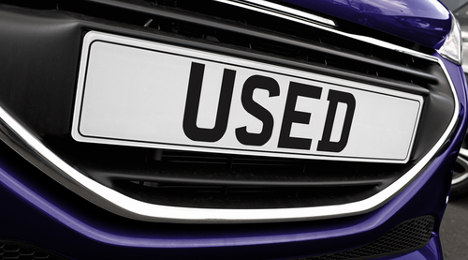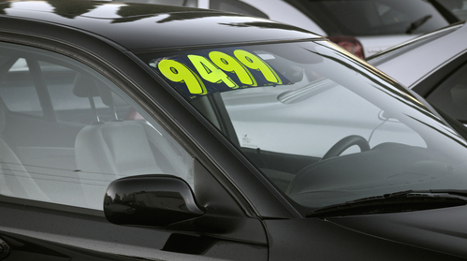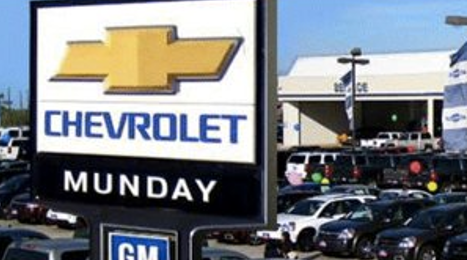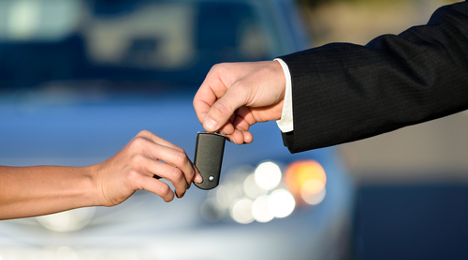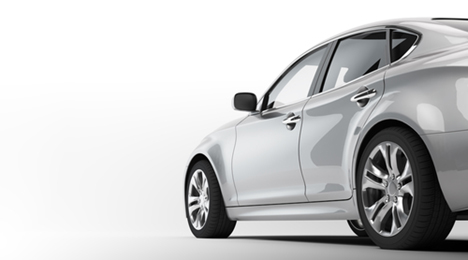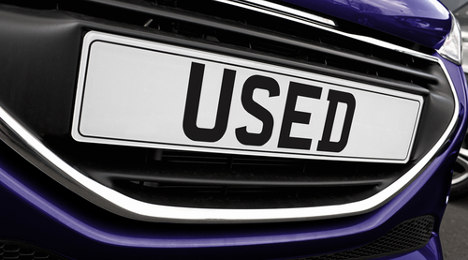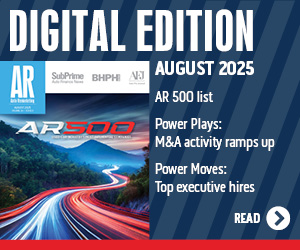Calling the customer reaction to the launch of the standalone used-car stores “overwhelmingly positive,” Q auto president Casey Coffey said the emails, letters and phone calls flowing in have expressed an appreciation for the experience at Q auto’s stores, with customers saying “that it was like none other that they’ve experienced in a car-buying atmosphere before.”
So, what makes the customer experience at Q auto different? Auto Remarketing caught up with Coffey to find out.
When a customer arrives on the lot at a Q auto store, he or she is not going to be immediately greeted outside their car.
“Most of them come into the store, and they’ll immediately notice that the sales associate — which are called product specialists — will meet them at the door or at the receptionist’s desk, and they’re holding an iPad,” Coffey said.
“And we take them through what Q is all about,” he said.
The customer is informed about Q auto's no-haggle pricing, that all cars are below market price, “and that they are really in control of the process.”
He continued: “We’re going to do virtually all of the sales process on the iPad. We take them through a video tutorial, and then we’re off and running to either look at automobiles on the lot or view automobiles on the iPad.
“Customers can sort through that any way they would like, whatever (way) fits their particular taste or how they want the experience to go. But the customer is the driving factor,” he said.
Technology appears to be big emphasis for Q auto, and its development was discussed during Asbury’s recent quarterly conference call.
Most of that technology centers around the iPad, Coffey said, acknowledging that “we’re not all the way there yet with our technology,” but the company is aiming to have that fully implemented by Q1.
He went on to explain how the iPads are being put to use, noting that instead of prices on the cars, the vehicles have Monroney stickers with QR codes.
The customer can use the iPad or his or her own smartphone to scan the code on a vehicle. Doing so immediately provides the customer with the car’s price and roughly 40 pictures of the vehicle (say, for instance, if the shopper decides not to buy that day, the pictures are saved for future reference).
Scanning the QR code also downloads a report from PureCars, which provides a litany of information on things like safety features, gas mileage, safety ratings and so forth. This also can be saved for future reference.
Additionally, instead of running the traditional F&I route where a customer meets with a finance manager after he or she has chosen a vehicle to purchase, the customer goes through the entire transaction process with the product specialist, Coffey said.
“There’s never a hand-off to another person,” he said, explaining that the finance information and loan approval process is all done via iPad.
Coffey also shared a bit about how Q auto stores generate inventory. For starters, they can source used cars from any of Asbury’s traditional dealerships, “which we do, quite often.”
When the Asbury dealerships have vehicles they don’t want or would like to transfer out of their inventories, Q auto gets first crack at acquiring those cars, Coffey said. Q auto also has a program, set up through one of its vendors, where it can view cars coming off lease into Asbury stores. Q auto also gets first shot at those.
Additionally, Q auto also buys cars from consumers regardless of whether the consumer makes a purchase, and it also uses more traditional routes like trade-ins and auction sales.
AutoNation reported a successful third quarter this morning, with an 8-percent spike in new and used retail vehicles sales along with a 10-percent bump in overall revenue.
The dealer group reported total revenue of $4.9 billion in Q3, a jump of 10 percent compared to the same period of 2013. Company management said revenue was up across all its major business sectors.
Operating income came in at $207 million, up 11 percent from the third quarter of 2013.
And earnings per share from continuing operating hit an all-time record of 90 cents, up 20 percent compared to the year-ago period.
Mike Jackson, chairman and chief executive officer, said, "AutoNation delivered its 16th consecutive quarter of double-digit year-over-year growth in EPS. This quarter we set another record for the highest ever quarterly EPS from continuing operations. As we look to 2015, we expect continued growth in new-vehicle unit sales, with 2015 industry new-vehicle sales above 17 million units."
New- and used-vehicles sales were both up, contributing to a favorable revenue outcome this past quarter.
The company retailed 56,584 used vehicles in Q3, up 7.5 percent from 52,659 sold during the same period of 2013. As of the end of September, the company had retailed 161,376 used vehicles year-to-date.
New sales were also up a bit in Q3. AutoNation sold 83,682 new vehicles last quarter, up from 76,943 sold during Q3 2013.
Looking at used vehicles specifically, the retailer was also making a bit more on these vehicles. Revenue per used vehicle retailed came in at an average of $18,489 in Q3, up from $17,718 during the same period last year. (Revenue per new vehilce retailed was up slightly as well).
Gross profit for the used department contributed to the company’s impressive Q3 results, as well.
Gross profit for used retail sales came in at $91.8 million, up a significant 11.4 percent from $80.4 million last year during Q3. As of the end of September, the company’s used retail gross profit was $273.3 million.
Gross profit per used vehicle retailed came in at $1,620 during Q3, up from $1,528 a year ago.
The company was recently busy in the acquisitions department, as well, coming off such a strong quarter.
In October, the dealer group completed the acquisition of Mercedes-Benz of Bellevue, Barrier Audi, Barrier Porsche, and Barrier Volvo in the Seattle-Bellevue, Washington market.
The annual revenue for these stores is approximately $355 million.
And just today, the company announced that Porsche Cars North America has awarded a new Porsche franchise to AutoNation in Orange County, Calif.
AutoNation expects that the new store will open in 2016 and currently anticipates annual revenue of approximately $100 million once fully operational.
For more insight into AutoNation’s Q3 performance, see the Wednesday edition of Auto Remarketing Today.
During its third-quarter conference call, Sonic Automotive highlighted several all-time records, including those set for new retail unit sales, pre-owned gross profit and third quarter total gross profit.
When asked if something was happening to separate Sonic from the pack during its strong quarter and used-vehicle sales increase of about 5 percent on the same-store side, Scott Smith, the company’s president and chief strategic officer, attributed the steady increase to his dealers’ consistent inventory levels, which have traditionally been light.
“I just think that with the great inventory management, our systems are running on a traditionally, versus the rest of the world, light day supply of 25-27 days,” Smith said. “If you go back and look at our performance, we just haven’t had those inventory pressures that caused those kind of adjustments. You’ve got to remember there are 42-45 million used cars sold every year and what makes a group go up and down, or a dealer go up and down, is just getting their inventory out of whack. We just haven’t had that kind of pressure here in a while.”
And, according to Smith, he doesn’t think they will face that kind of pressure again, due to his faith in Sonic’s digital inventory management systems. Smith also believes the sales will retain their consistency for the foreseeable future.
“I think the used-car business is pretty solid,” Smith said. “Our volume is decent. We sold 90 cars per rooftop, and we want to be at 100, but it wasn’t too bad. Our gross was good. Over $1,500 for us; that’s the highest it’s been in a while.”
When asked if they should be keeping higher inventory levels going into the coming months to drive sales, Jeff Dyke, Sonic’s executive vice president of operations, seemed to think that going into the winter months light is the way to go.
“You never want to have a heavy inventory coming out of July, August, September time frame,” Dyke said. “All the dealers start selling their cars in October, November and December, all the mom-and-pops and single dealership owners are clearing up inventory. You can see some of the bigger dealership groups doing that now, it’s a great time for us to buy. So you’ll see us push our inventory levels up in the fourth quarter.”
While remaining conservative with its inventory, and also continuing to test the waters with its EchoPark and One Sonic-One Experience, Smith remains optimistic, even hinting at further group growth.
“It wouldn’t surprise us at all that a couple more dealerships enter the Sonic family here in ’15,” Smith said. “That’s both from an acquisition and an add-point perspective.”
Like many dealerships are facing nowadays, Group 1 Automotive had to turn more used vehicles to push its overall revenue and gross profit figures higher during the third quarter because gross profit per unit softened by 3.3 percent, or $52, per vehicle.
The company’s top-line third-quarter metrics in the used department settled with retail revenues increasing 16.2 percent on rising unit sales of 10.4 percent. Group 1’s total retail used-vehicle gross profit increased $6.8 million to $44.3 million. But drilling down deeper into the company’s quarterly report showed the road Group 1 had to navigate to reach those figures.
Group 1 retailed 24,917 used vehicles in Q3, up from 22,206 units in the year-ago period. Meanwhile, the company’s gross profit per unit dipped to $1,535, down from $1,618. And that movement came as the average retail asking price moved up 3.6 percent year-over-year in the third quarter, rising from $19,982 to $20,705.
While much of the company’s quarterly conference call focused on Group 1’s activities in the U.K. and Brazil, Wall Street observers still wanted to know why the used-vehicle performance settled the way it did.
“There was some pressure in the used-car business in the quarter,” Group 1 president and chief executive officer Earl Hesterberg said. “First of all, after August, generally, there's a seasonal pressure in terms of downward prices in the guidebooks.
“But also I think it's been well-publicized that there is some increasing supply with off-lease vehicles. And then, in addition, there were some pretty aggressive new-car marketing pushes, particularly through Labor Day and August. And I think new-car prices and transaction prices probably sat down on used-car prices,” Hesterberg continued.
“So when the market shifts like that and there's pressure on demand, I think we all try to keep our inventory turning and keep it clean,” he went on to say. “So we've probably retailed some vehicles at a lower margin rather than send them to auction and take a small wholesale profit. I think it's a combination of increasing supply and new-car pressure pushing down on used-car demand.”
Later in the call, another investment analyst wondered if Group 1 is seeing new-vehicle leasing take away from business that might have boosted the used department.
“I think most of the OEMs in the recent one- to two-year period have gotten fairly aggressive in leasing, but I haven't seen anything atypical lately,” Hesterberg said.
Elsewhere in the financing realm, Group 1 posted a 5.5-percent jump in F&I gross profit per unit as it moved up to $1,450 from $1,375 in the year-ago quarter.
On the new-car side, Group 1 sold more new models without grosses slipping. Company dealerships retailed 36,649 new vehicles in Q3, up 11.5 percent from the last year’s third quarter total of 32,866 vehicles. And the gross profit per new vehicle ticked up 2.7 percent, going up to $1,691 from $1,646.
As an entire company, Group 1 reported that Q3 adjusted net income came in at $39.8 million, which equates to a diluted earnings per common share of $1.57. The company added total revenue grew 12.2 percent to an all-time record of $2.6 billion.
Group 1 pointed out that the quarter included several significant non-recurring charges, especially relating to a convertible senior notes repurchase, which resulted in GAAP net income and diluted earnings per share of $26.2 million and $1.03, respectively. Adjusted net income increased 21 percent from the comparable, adjusted prior-year period.
On a GAAP basis, the company said its net income decreased 20.2 percent from the comparable prior-year period.
Year-to-date adjusted net income increased 9.1 percent, according to the company, which also mentioned adjusted diluted earnings per common share for the first nine months of 2014 were $4.22.
On a GAAP basis, officials computed net income decreased 19.4 percent from the comparable prior-year period.
Group 1 acknowledged adjusted net income for the third quarter of 2014 excludes $13.6 million of net, after-tax adjustments, including $17.9 million of charges related to the repurchase of our 2.25 percent and 3.00 percent convertible notes, and $6.6 million of asset impairments primarily associated with the pending disposition of vacated U.S. dealership real estate and three Renault franchises in Brazil.
The company added these charges were partially offset by a net $8.6 million gain on the sale of U.S. dealerships and associated real estate, and a $3.4 million income tax benefit related to deductible goodwill in Brazil.
"We are delighted to announce all-time record earnings this quarter, with the results driven by strong expense leverage and significant revenue increases across all of our business sectors,” Hesterberg said
“Our international businesses were major factors in our success, with our United Kingdom operations delivering all-time record earnings for the quarter and our Brazilian operations returning to profitability following a significant restructuring,” he added.
Store Footprint Developments
As mentioned in its report, Group 1 made several moves with its stores during the third quarter.
Looking solely at its decisions in the U.S., Group 1 acquired a Chevrolet franchise and Mazda franchise in Houston and a Mercedes-Benz franchise and Sprinter franchise in San Antonio. Meanwhile, the company divested its BMW, Mini, Mercedes-Benz and Sprinter franchises and associated dealership real estate on Long Island in New York. The company also disposed of a Honda franchise in Freehold, N.J., and divested a Volkswagen franchise in Holiday, Fla.
“In the case of exiting the Long Island market, it was just very high-cost place to do business,” Hesterberg said. “We had some major capital expenditures required that was only going to make that worse. And we just didn’t have a consistent track record of generating the profits that we needed for a good return for our shareholders.
“So we had opportunities to invest in places like Texas, where we are highly confident that we have scale, leverage and know what we will get out of an investment,” he continued. “It was really kind of a shareholder-driven thought process.
“Each market is so different and the dynamics are so different. We’re constantly evaluating that, and it’s kind of hard for me to prognosticate much beyond that,” Hesterberg added about what Group 1 might do next.
However, Hesterberg did discuss how Group 1 is performing regionally, reiterating the company’s strength in the Lone Star state.
“Texas remains very strong and so does Boston and New Hampshire,” Hesterberg said. “The weaker area for us has been New Jersey and New York. We exited New York, and New Jersey is still a challenge for us.
“We have dealerships in Atlantic City, and you've probably read about the casinos and some of the issues in that part of the world so that’s still a weak area,” he continued. “Also on the Gulf Coast, in particular, New Orleans, in fact all of Louisiana, the new-car market is down significantly this year.”
So might Group 1 keep looking to buy stores in its strongest regional markets? Hesterberg didn’t share any specifics.
“We had some opportunities earlier in the year, and they were large opportunities, and I believe those will work well for our shareholders. I don't see those same opportunities for our company at the moment. It does appear that prices have gotten very, very high. And while there still seems to be a lot of businesses on the market, I don't see that type of pace in the U.S. in the near term,” Hesterberg said.
“I have seen more deals on the market in the last couple of months. But the ones that I've seen, the prices just wouldn't work for a proper return on investment. So that can change tomorrow. It's very dynamic,” he continued.
“Almost every deal starts with an asking price that's too high,” Hesterberg added. “There is potential for more acquisitions because there are so many deals out there and prices do get negotiated.”
Perhaps the best way to describe the state of Asbury Automotive Group’s Q auto stand-alone used-car retail program would be this: it’s a work in progress that certainly has made some progress.
Asbury opened a Jacksonville, Fla., Q auto store in October — the company’s second Q auto location — and has plans to roll out a third store in Fort Myers, Fla., during the fourth quarter.
During the retailer’s third-quarter earnings conference call on Tuesday, investment analysts asked Asbury management several questions about Q auto, including where the program stands in terms of development.
“We’re still in the early stages of development. We are committed to do the third store, and we’re very excited about the results that we’ve seen. I think the major parts of this that we’ve learned is that there are different ways to sell cars to the consumers. We’re learning that we can make that work,” said Michael Kearney, Asbury’s executive vice president and chief operating officer.
“We are developing some technology that is different than what we use in our other stores that is very promising and may be expandable in the future,” he continued. “And we’re learning, as we know from the other business, that there is a substantial amount of Internet business that is out there.
“So, it has been a learning experience. We are very pleased with the results so far," he added.
One strategy that Asbury president and chief executive officer Craig Monaghan emphasized during the call was this: “We are trying to control the amount of capital that we tie up in these stores, as we work on these prototypes.”
The first Q auto location, which opened in Tampa, Fla., is in a leased facility, Monaghan said. The company did do some refurbishing to the facility, brought in signage and so forth, but the real spend there was in people and advertising, he said.
The retailer is working with their partners to bring about new technologies for that store “that we don’t see anywhere else,” Monaghan noted. There has been some spending on technology, but most of that is in the form of infrastructure, as a lot of the software work is being done by Asbury’s partners.
Meanwhile, Asbury owns the facility housing the second Q auto store (Jacksonville). The site was vacated when Asbury transitioned the Toyota store it had there to a new facility.
“We think there’s a lot to be learned in this space,” Monaghan added. “One of the things that we’ve learned from others is that it seems to be that the smart thing to do is to minimize capital and try to maximize throughput. And that’s exactly what we’re working on.”
Throughout the call, a few more interesting nuggets about Q auto came up. One was that inventory for Q auto stores will go through their own reconditioning and prep work. Additionally, Asbury is anticipating Q auto will keep the same target of 30- to 35-day used-car supply that its other stores have.
“When you open one from the beginning, the first one or two months you may see something a little higher than that because we have to acquire (the vehicles) all at one time,” Kearney said. “But on an ongoing basis, you could expect that Q auto would keep the same disciplines and days’ supply as our other brands.”
There were two key factors driving down used-car gross margins for Asbury Automotive Group during the third quarter, but the period had some very positive results in both pre-owned and overall results.
Starting with some of the used operational results, Asbury’s Q3 same-store used retail gross profit was up 1 percent at $31.9 million. Executive vice president and chief operating officer Michael Kearney explained on Tuesday’s quarterly conference call that this was driven by same-store used unit retail volume growth of 2 percent, with 19,178 used cars sold, but partially offset by a 30-basis point decline in same-store retail gross margins.
Specifically, Asbury’ s same-store used-vehicle retail gross margins fell 0.3 percentage points year-over-year in the third quarter to come in at 8.2 percent.
Kearney specifically pointed out two challenges the retailer faced on the used side: a hefty inventory of used cars (41 days’ supply) at the outset of the quarter and a “declining price environment, pressured by increased manufacturer new-vehicle incentives.”
And having to slice the inventory to a 35-day supply by the end of Q3 dropped margins to that 8.2 percent level. But Kearney would also note the company expects margins to mirror what Q3 year-to-date average was: roughly 8.5 percent.
Sharing more used-car statistics, Asbury said same-store revenue per used unit retailed was at $20,388 during Q3, a 3-percent year-over-year increase. Same-store gross profit per used unit retailed fell 1 percent at $1,663.
Looking at results through nine months of the year, Asbury has generated:
- $97.1 million in same-store used retail gross profit, up 4 percent year-over-year.
- 55,315 same-store used retail unit sales, up 5 percent year-over-year.
- Same-store used revenue per unit retailed was $20,412, up 3 percent year-over-year.
- Same-store gross profit per used vehicle retailed was $1,755, a 1-percent decrease.
- Same-store used retail gross margins were 8.6 percent, down from 9.0 percent a year ago.
Commenting on overall results in the company’s earnings announcement, Asbury president and chief executive officer Craig Monaghan said: “Asbury is pleased to announce another record third quarter EPS from continuing operations.The overall automotive retail and lending environments remain healthy. Going forward we will continue to execute our two part strategy: to drive operational excellence and to deploy capital to its highest returns.”
Kearney added in the announcement: “Our current quarter results demonstrate, once again, the strength and diversity of our business model. While we did experience some pressure on new- and used-vehicle margins, our parts and service gross profit grew at 12 percent, driven principally by growth in warranty and reconditioning.”
Sonic Automotive reported its third quarter results today, highlighted by several all-time records.
In addition to setting an all-time record for new retail unit sales (36,301 units, up 6.5 percent year-over-year), Sonic also set a new all-time record for pre-owned gross profit, revealing a 5.8-percent increase year-over-year with a pre-owned gross profit of $41.2 million.
The company’s total gross profit was a third-quarter record at $341.5 million, up $15.4 million, or 4.7 percent, over Q3 2013.
Pre-owned revenue was up 23.7 million for the company, an increase of 4.2 percent over last year, with a pre-owned unit sales per store per month of 90 units.
“Our team worked very hard during the third quarter and it definitely paid off,” Scott Smith, Sonic’s president, said. “We were able to deliver record-breaking results while still driving forward with our EchoPark and One Sonic-One Experience initiatives. Initial results from our One Sonic-One Experience test store in Charlotte met our expectations and we plan to continue the rollout of this initiative to the entire Charlotte market in the fourth quarter.
“The fourth quarter also involves our grand opening of EchoPark in Denver which we believe, together with our One Sonic-One Experience initiative, will transform the retail automotive buying experience," he added.
Total net income from continuing operations for Q3 2014 was $24.6 million, or $0.47 per fully diluted share, compared to $24.7 million and $0.46 for Q3 2013. This year’s Q3 results include a net pre-tax gain of approximately $0.8 million, or $0.01 per diluted share, related to a gain on disposal of franchises, partially offset by severe storm damage and impairment charges, according to the company.
The company also repurchased approximately 1.2 million Class A common shares during the quarter in open market transactions, with approximately $93 million of remaining share repurchase authorization.
In addition to announcing the acquisition of a Nissan store in California late last week, Lithia Motors shared a sneak peek Monday of what its third-quarter results might entail, including some projected used-car numbers.
According to preliminary results, Lithia increased its used retail same-store sales by 13 percent during Q3. However, there was some pressure on used-car margins.
“Our top line revenue, new vehicle sales, service and parts and F&I per unit exceeded expectations," president and chief executive officer Bryan DeBoer said in Monday’s release.
“Used-vehicle margins were approximately 130 basis points lower than anticipated primarily due to declining used-vehicle values,” he added. “Used-car same-store sales grew 13 percent, but lower gross profit coupled with modestly higher selling costs impacted operating income.”
New Store in California
Elsewhere, the retailer announced Friday that it purchased Harris Nissan in Clovis, Calif. The group anticipates the store will bring an additional $25 million in estimated annual revenues into the Lithia fold.
It will be renamed Lithia Nissan of Clovis.
DeBoer said: “We are pleased to add to our Nissan portfolio in the central valley of California. Lithia Nissan of Clovis will complement our Fresno location as we cluster locations in the greater Fresno market area. We are pleased to welcome the newest members of the store to the Lithia family.”
Less than five months after debuting the Q auto program in Tampa, Fla., another stand-alone used-car store from Asbury Automotive Group has officially opened, the retailer announced this morning.
The second store under the Q auto brand is located in Jacksonville, Fla.
The company is aiming for Q auto to be a “different approach to car buying,” through its one-person, one-price shopping experience as well as offering shoppers the chance to reserve and buy cars online via qauto.com.
The program’s “Q Protected” benefits include a five-day/unlimited-mile return policy, a Carfax Buyback Guarantee, and a 75-point Inspection, just to name a few. Additionally, Q auto says it will fix the first “ding or dent” the car gets for free.
The company said Q auto also services all vehicle makes and models regardless of whether or not it was bought at a Q auto.
Casey Coffey, president of Q auto, explained the integral part that “Q” plays in the program’s branding and culture.
“Q stands for Quality, Q stands for Quantity, and Q stands for Quickly — three things that we know are very important to our customers. With Q auto, we've launched a new brand that will change the buying experience by providing a completely transparent sales experience that the customer controls,” Coffey said. “We have all the latest technology to allow the purchase process to be easier than ever. Our buying experience is handled by one Q product specialist from beginning to end.
“We want to develop a brand that creates a unique purchase experience. Our selection, our process, our cutting-edge technology and most importantly our people are different than what is generally expected. We want Jacksonville to recognize Q auto as their car dealer,” Coffey added.
CarMax reported a record second quarter this week, reflecting an increase of 6 percent in total used-vehicle sales.
An interesting statistic helping to drive those sales, according to the company’s executive vice president and chief financial officer Tom Reedy, continues to be the financing options available to CarMax customers through its variety of lenders.
“They’re down slightly but we’re still seeing over 90 percent of our customers receiving approval of some kind in our stores,” Reedy said during the company's latest quartersly conference call. “If you remember, as we’ve been talking about the last couple of quarters, the decline in subprime business is more a byproduct of the nature of the offers that the lenders are providing. Whereas in the past a $13,000 loan may have had a $100 or $200 down payment required, that number may be several hundred dollars higher today, making it a more difficult transaction for the customer. So it’s a combination of a number of things. But as far as actually receiving an offer, it’s still very strong in our stores, and overall we’re very happy with the finance environment. I think we have a great array of lenders for our customers, and customers have great access to financing in the CarMax system.”
When asked if new-car incentives were hurting used-car sales, the company’s president and chief executive officer, Tom Folliard, was not sure of a definite answer but still reflected that, regardless of new-car sales, the vehicles and new buyers will eventually come back to their business.
“It’s really hard to tell the reasons why somebody would buy new over used, but I think it’s good for us when we see the SAAR continue to grow,” Folliard said. “As we talked about, over time it will have long-term benefits for us, both on the supply side and the fact that consumers are more willing to get out there and sign for a loan and buy a car.
“In terms of the new-car sales translating to future supply, I think you said we’re in the early innings, and I would agree with you although we’ve seen a nice pick up in SAAR,” Folliard continued. “The supply trickle down will happen over the next couple of years. We’re excited about that; we have said in the past that we historically over-perform in 2-, 3-, 4-year old cars. That mix of sales for us was slightly up in the quarter but not very much, and so we still think that is yet to come.”

